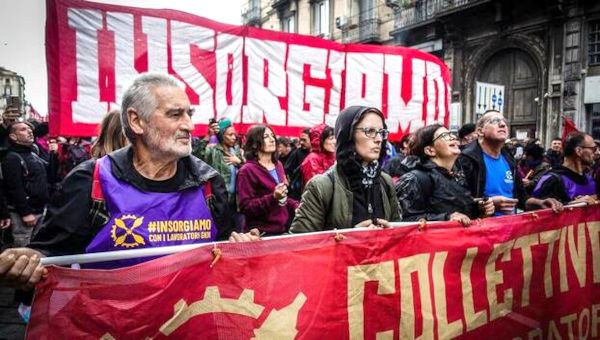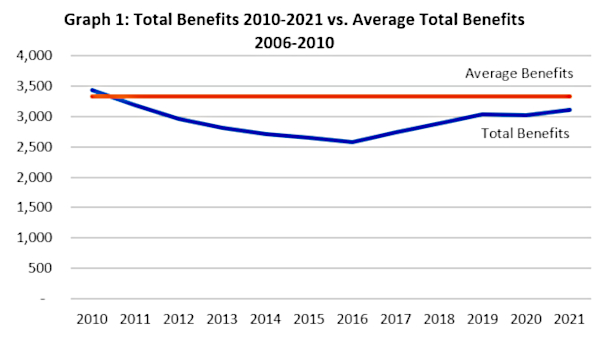Southern Labour is the Key to Change in the United States, and hence Canada, and the World
The Importance of the US South
The South is today, as it always has been, the key to understanding American society: its politics, its constitutional anomalies and government structure, its culture, its social relations, its music and literature, its media focus and their blindspots, and virtually everything else. The South is a distinctive, atypical part of the United States; it is also, however, America writ large.
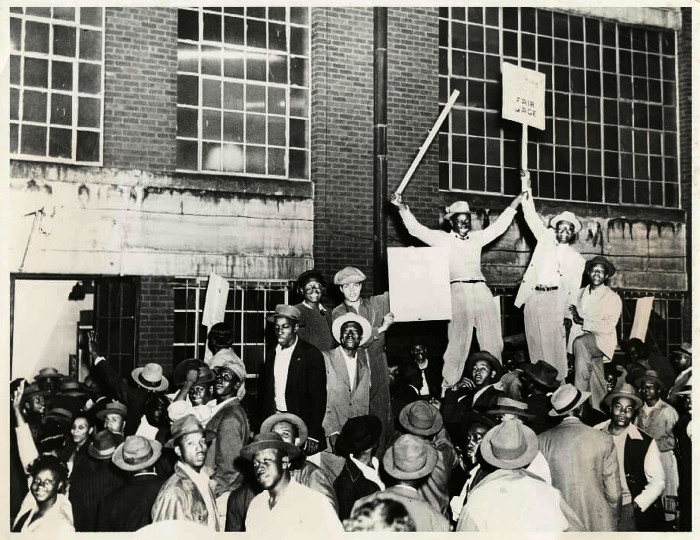
The bedrock of this understanding begins, not with the culture or social history of the South, but with its economy, and the racial/social relations that have sustained it. W.E.B. Du Bois, perhaps the most penetrating – and, in my opinion – greatest American social scientist of the 20th century, understood this well. Du Bois argues implicitly that the answer to the old question, originally posed by Werner Sombart of “Why no socialism in the United States?” (by which he meant, why the United States was unique among industrial countries in not having an electorally significant working class supported labour, socialist, social-democratic, or communist party) really reduces to “Why no liberalism in the South?” The South, according to Du Bois, was inherently reactionary, so there could be “no successful third party movement” in the country as a whole (by which he meant one with a left-wing labour focus), until the South changed dramatically.
And, because of the degree to which the US and Canadian economies are intertwined, and that many of the most important unions (pretentiously and chauvinistically called “international”) have been Canadian and US in membership, this story has direct relevance to Canada as well. Among these “international” unions have been those in auto, coal, steel, metal mining, and wood.
This story, of course, begins in colonial times, first with the development of tobacco and sugar crops, later cotton, all produced largely with slave labour. Here, I wish to probe the somewhat more recent history of the South, especially the failure during the 1930s, 40s, and 50s of organized labour to fully unionize the main southern industries (whose success, I argue, had the potential to radically transform the South, and, thus, the nation, and perhaps all of North America, as a whole), a factor which plays a central role in understanding the nature of North America today. Further the failure of unions to organize the South was not at all predetermined, either then or currently.
The Uniqueness of the South
The legacy of slavery and white supremacy have left a callous disregard for human dignity and the sanctity of human life (despite the strength of allegedly pious anti-abortion activists) in the South today. It is reflected among other places in the distribution of death penalty executions. Over 80% of the 1,460 executions since the death penalty was reinstated in 1976 have been in the South, with over half in three states alone: Texas, Oklahoma, and Virginia. This lack of respect for human life is itself the heritage of African slavery and the plantation system. The low levels of social support for those in need (be it children’s healthcare, unemployment insurance, workmen’s compensation, and disability benefits) is also perhaps reflective of these attitudes.
The South continues to this day in general to have the lowest levels of unionization, the most anti-union laws (the location of the overwhelming majority of anti-labour so-called “right to work” laws), and the most egregious violations of worker safety. It is not surprising that it is the part of the country with the lowest level and lowest support for public education and healthcare. And, it is probably far from a coincidence that Texas today, despite being relatively affluent, is the state with the largest percentage of people without health insurance. In 2015, 17.1% of Texans had no health insurance, nearly double the national average of 9.4%. Of the twenty-two states with a higher proportion of uninsured than the national average, eleven were in the South.
The low levels of unionization are in good part the reason for so much ignorance and superstition. Lack of working class organization leads to atomization, individualism, and an increased receptivity to manipulation by dominant economic interests. As a result, the South is the region where the largest percentage of people are Birthers (those who believe that Barak Obama was not born in the US), reject evolution, and the existence of global warming; evidence to the contrary on these issues notwithstanding. It is in the South that there exists increased legislative pressure for teaching Creationism in public schools – for instance, the Texas bill (HB 1485) that would effectively enable teachers to teach both Creationism and climate change denial. And, the South, is the place where Donald Trump has the most support, especially among white people.
None of this is to argue that the South is all bad. The South has played a significant, enriching role in American culture, its cuisine, its home as the birthplace of blues and jazz, and much more. American literature would be less rich without southern writers (some of them emigres from their oppressive birthplaces). It is more recently the site of many great universities and research centers, some of which produce far more African-American Ph.Ds than institutions in the allegedly more liberal and racially tolerant North. Thirteen of the top 20 doctorate granting institutions for black Ph.Ds are in the South.
It also has been the area where some of the country’s most valiant popular struggles have taken place. Whites and Blacks in many places fought slave-owner-led secession before the Civil War, even engaging in guerrilla war against the confederacy in Jones County, Mississippi. Successful interracial labour organizing took place throughout the South in the late nineteenth and early 20th centuries, under the banner of first the Knights of Labour, later the Industrial Workers of the World (IWW). The interracial labour battles of the 1930s and 1940s and the 1950s to the 70s civil rights struggles taking place in the South, served as inspirational beacons in the last century.
Nevertheless, the South remains, as Du Bois so poignantly argued, a distinct reactionary region of the country, and this has been the case since the colonial era.
Myths About Southern Culture
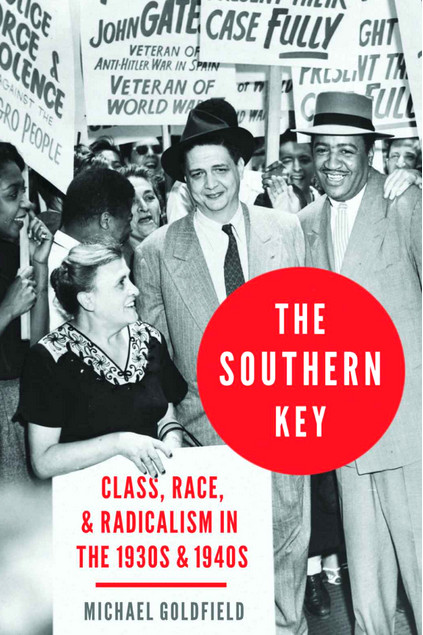 There are a variety of myths, promulgated in good part by an extensive sociological literature, that attributes the low levels of unionization in the South to the attitudes and culture of southern workers. Workers there are allegedly too individualistic to subordinate themselves to collective organization. In addition, it is also argued (a bit contradictorily) that workers’ agricultural background makes them especially submissive to authority figures, unwilling to strike or challenge those in power. Yet, the historical record, as I attempt to document, in my recently published The Southern Key: Class, Race, and Radicalism in the 1930s and 1940s, belies this conclusion.
There are a variety of myths, promulgated in good part by an extensive sociological literature, that attributes the low levels of unionization in the South to the attitudes and culture of southern workers. Workers there are allegedly too individualistic to subordinate themselves to collective organization. In addition, it is also argued (a bit contradictorily) that workers’ agricultural background makes them especially submissive to authority figures, unwilling to strike or challenge those in power. Yet, the historical record, as I attempt to document, in my recently published The Southern Key: Class, Race, and Radicalism in the 1930s and 1940s, belies this conclusion.
Southern workers, white as well as Black, have a rich legacy of struggle and organization, from the 19th and 20th century organization on the docks in New Orleans and elsewhere, to the broad interracial organization in the late 19th century across many industries under the rubric of the Knights of Labour. Southern woodworkers, especially in Louisiana and Mississippi unionized interracially, under the militant leadership of the Industrial Workers of the World from 1911-1913, while southern workers across the South, like their compatriots elsewhere in North America, organized across industries during World War I.
During the 1930s and 40s, as industrial workers across North America organized, southern workers also formed unions, albeit less extensively than in the North. I want to highlight one surprising area where they were especially strong – the State of Alabama.
Alabama Exceptionalism
Alabama, along with Mississippi, South Carolina, Louisiana, and Georgia, was the heart of the Deep South. Controlled by Black Belt plantation owners and their industrial allies in Birmingham, voting for the white supremacist (read “racist”) States’ Rights “Dixiecrat” presidential candidate Strom Thurmond of South Carolina in 1948, fervent supporter of its overtly racist governor George Wallace in 1964 and 1968, Alabama seems an unlikely place for interracial liberalism and radicalism to take root. The state was as gerrymandered or “gerry-rigged” in favor of rich white cotton owners – enshrined in the 1901 Alabama state constitution – as any state in the South, and hence the US. Even in the 1960s, for example, the 1,600 whites in Lowndes County had equal representation at the state level to the half million citizens living in Jefferson County, which included Birmingham (the 23,000 Blacks in Lowndes County, as elsewhere in much of Alabama, were completely disenfranchised). Lynchings, chain-gangs, and rigid segregation were part of the scene.
Yet, in 1946, when the CIO-endorsed, left-populist, James (“Big Jim”) Folsom was elected governor, the ever-optimistic Nation declared Alabama, “the most liberal state in the South.” While Folsom was a bit unique, even in Alabama, he was not alone. Alabama had a history of electing relatively pro-labour, non-segregationist state-wide candidates, including Senators Hugo Black, Lester Hill, and John Sparkman. Folsom, even in this context, however, stood out. Calling himself the “little man’s big friend” (he was 6’8″ [2 m] and well over 270 pounds [122 Kg]), he was rooted squarely in the tradition of Alabama’s hill country radical populist tradition.
Folsom, in contrast to most other southern governors, not only argued for more opportunities for Blacks, he explicitly stated that “Race was a phony issue, a ploy used by the rich and powerful to divide poor people and blind them to their common interests.” He opposed the poll tax and argued that all African-Americans in Alabama should have the right to vote. He made a point of welcoming African-Americans to his campaign rallies, shaking hands with them the same as everyone else. And, even as the storm of white backlash was enveloping Alabama, along with the rest of the South, Folsom (who had been elected for a second term as governor in 1954) in November, 1955, not only invited flamboyant African-American Harlem Congressman Adam Clayton Powell to the statehouse, but had a limousine pick him up at the airport and was photographed in the governor’s mansion drinking Scotch with him. He called the near unanimous resolution of the Alabama legislature – declaring the 1954 Brown vs. Board of Education Supreme Court decision (which unanimously ruled that school segregation was unconstitutional) null and void in Alabama – to be “a bunch of hogwash.” I am not, of course, suggesting that Folsom was a militant civil rights activist or consistent integrationist, but merely that he was well outside the Dixiecrat consensus that ruled much of southern politics at the time.
So, why did Alabama – a hardcore, Deep South, Dixiecrat state – appear for a time to be so different? Of course it had its share of up-country whites, who chafed at the rule of their state by the Dixiecrats and their allies, who had no particular use for white supremacy. Many of these areas had historically opposed the Black Belt plantation owners. They had opposed secession, and often fought for the Union during the Civil War, supported the Populists in the 1890s, even voted for Socialist candidate Eugene Debs for president in 1912 and 1920. Yet, this hardly made them unique in the South, nor were their numbers in Alabama particularly high compared to other states.
What made Alabama exceptional was that in the 1940s it was the most unionized state in the South. Union membership had increased from approximately 70,000 in 1933 to over 200,000 in 1945, over 25% of the labour force in that year. To put this in perspective, the percentage of workers unionized in Alabama in 1945 was higher than exists in any state in the United States today. The Alabama labour movement was centered in the Birmingham area, the stronghold of the United Mine Workers, who had already shown their strength in 1928 by leading a coalition that successfully abolished convict labour in the state. The roughly 23,000 unionized coal miners in Alabama were clearly the vanguard of the labour movement, aiding in the organization of all other workers across the state in the 1930s, including steel workers, wood workers, textile workers, school teachers, and even principals in one county.
They were joined by others in the Birmingham area, including steel workers and metal mine workers, tens of thousands strong. There were also industrial enclaves across the state where textile and other factory workers were organized including Gadsden and Huntsville. Workers in shipbuilding and those who worked for the federally run Tennessee Valley Authority centered in Muscle Shoals, Alabama, were fully organized. Finally, longshoremen in Alabama – 95% of whom were Black – were organized, including those in Mobile, Alabama’s largest port. Unionized areas during the 1930s and 1940s, consistently supported more liberal, pro-labour, non- segregationist candidates, as well as voicing opposition to poll taxes. Thus, the high level of union membership in Alabama is suggestive of the degree to which further unionization of Alabama and the South as a whole might have politically transformed the region.
“Wall to Wall” in Alabama
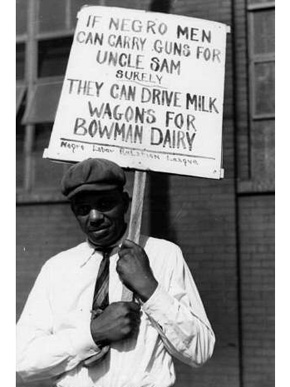 Coal miners struggled not only for themselves but took a broad view of their role and responsibilities within the labour movement. This was certainly evident in the coal mining counties of northern Alabama. In Walker County, just northwest of Jefferson County (the latter containing Birmingham), coal miners like their brethren elsewhere became fully organized in 1933. They then proceeded to organize workers in virtually every other industry and occupation, “wall to wall.” Not only coal miners, but the many wood workers, hod carriers, washer women, preachers, and school teachers all became organized. According to the Union News, the Walker County CIO newspaper, the county was the most highly unionized county in the country, with, at least according to one report, even school principals unionized. What was the case in Walker County was also so in many other counties in northern Alabama, where coal miners were organized. Coal miners were also the strongest supporters of the Farmers Union, which was successful in northern Alabama in organizing Black and white sharecroppers and renters, not merely in Walker County, but in Bibb, Tuscaloosa, Marion, and Shelby Counties.
Coal miners struggled not only for themselves but took a broad view of their role and responsibilities within the labour movement. This was certainly evident in the coal mining counties of northern Alabama. In Walker County, just northwest of Jefferson County (the latter containing Birmingham), coal miners like their brethren elsewhere became fully organized in 1933. They then proceeded to organize workers in virtually every other industry and occupation, “wall to wall.” Not only coal miners, but the many wood workers, hod carriers, washer women, preachers, and school teachers all became organized. According to the Union News, the Walker County CIO newspaper, the county was the most highly unionized county in the country, with, at least according to one report, even school principals unionized. What was the case in Walker County was also so in many other counties in northern Alabama, where coal miners were organized. Coal miners were also the strongest supporters of the Farmers Union, which was successful in northern Alabama in organizing Black and white sharecroppers and renters, not merely in Walker County, but in Bibb, Tuscaloosa, Marion, and Shelby Counties.
The coal miners in Alabama provided leadership and support for all other workers in their struggles. Textile workers in Alabama were among the earliest to organize in the South. Among southern textile workers they were the vanguard of the events leading up to the 1934 textile general strike, and by far the strongest contingent in the South. They were strengthened by their ability to count on the ready support of the over twenty-three thousand organized coal miners in the state, and a state government more reluctant than many others, especially in the South, to mobilize its repressive powers in support of textile company owners, whose political strength they had to weigh against that of the highly unionized workforce.
Southern workers successfully organized during the 1930s and 40s in a large number of industries, including coal and metal mining, longshore, auto, steel, oil, meat slaughtering, farm equipment, and others. The Congress of Industrial Organizations (1935 to 1955 – CIO) consolidated and extended its gains in a number of important southern industrial centers including Gadsden, Alabama, Memphis, Tennessee, New Orleans, Atlanta, and in Laurel, Jackson, and Natchez, Mississippi. In Laurel, Mississippi, a town of 30,000 inhabitants, the CIO had more than 6,000 members. In late 1948, the Textile Workers Union won an election at the Laurel Textile Mill, the last major nonunion plant in town. This victory came despite the fact that openly white supremacist Senator Theodore Bilbo and Representative John Rankin came to town specifically to campaign against the CIO (Business Week 1948), which (unlike the UAW defeat at Volkswagen in Chattanooga in 2014) did not stop the majority white workers there from voting overwhelmingly for the CIO.
Yet, unions eventually were defeated in the two largest southern industries, textile and wood. In other places, their unions often degenerated into tepid organizations, failing to challenge the racist status quo. None of this was predetermined.
The South Today
The southern economy has vastly changed since the 1930s and 40s. Coal has virtually disappeared and is not coming back. Textile production is gone. Basic steel is also gone, although certain types of steel fabrication remain. Yet, the South has a far greater economic dynamism than it ever had. It has a large number of economically vital cities, including Miami, Atlanta, Houston, Dallas, Austin, Charlotte, Memphis, and many others. It is an expanding arena for auto production (especially among foreign transplants) as well as a growing center for auto parts production. Oil and other energy production are important, while new industries from catfish farms, chicken and pork growing and processing, and other food production, to aerospace have emerged.
Budget cuts, particularly in Republican dominated states have so impacted government workers, especially schoolteachers, that waves of militant strikes have emerged. Logistic hubs serving the new digital economy are located in many major southern cities. Those working in warehouses, food delivery, and other vital occupations, whose importance to all of us is underscored dramatically during the Covid-19 pandemic, seem to be gaining new collective energy and militancy. Thus, the possibilities for a new southern labour upsurge seem palpable, and opportunities for insurgent, more radical leadership are not inconceivable. •
This article is based on Michael Goldfield, The Southern Key: Class, Race, and Radicalism in the 1930s and 1940s (Oxford University Press, 2020). [Use promotion code AAFLYG6 to save 30%!]


